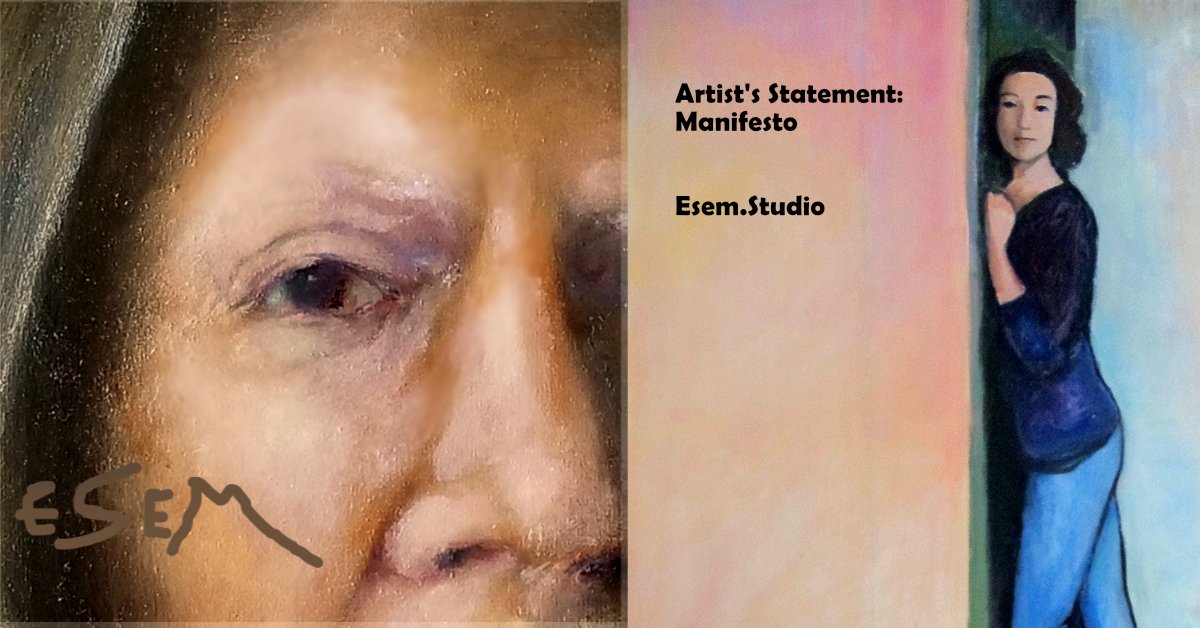My Artist’s Statement and Manifesto – 081124
My name is Stephen Michael Barnes – professionally now I go by the name Stephen Michael. I have chosen to shorten this to ESEM ( hence the website name and so forth.)
I am a painter. I have been painting since I was a child. The commercial work that I do now I would describe as “creative content production.” I do social media and website design and management. I paint in oils.
Someone once said that there are painters who think and thinkers who paint. I am both. My (upcoming) YouTube channel will be a presentation of a variety of topics such as how to paint how to paint in oils, philosophy of art, philosophy of being a creative person, and some social and cultural commentary since I believe that art is an integral part of the social and cultural context of any society.
What we are experiencing now in the 21st century (in 2024) is a society – a global society – which is laboring under a confusion between art, the meaning of art and art as product, as “content.”
The situation traces back to really the enlightenment to the 18th century and into the 19th century where philosophers and the big thinkers began to draw a distinction between “artisan” and “art” with a capital A.
Moving forward into the 20th century there was the growing divide between art as described as fine art (“Art”) and other forms of visual arts such as cartooning, comic strips, comic books, and illustration.
When I was in art school (briefly) in mid-1970s, it was made quite clear that there was a difference between Art and illustration. I recall one fellow student who was an excellent draftsman. He could draw beautifully with just a pencil or pen and with remarkable ease and facility. One of my painting/drawing teachers criticized his work as being mere “illustration” and not ART.
In 2024 given the rapid proliferation of artificial intelligence and the ability to turn out images with the frequency of raindrops in a storm, we – the human civilization – find ourselves in a situation where we are really having a difficult time distinguishing between mere production and the actual qualities and appreciation of art. This is in part because we don’t have a clear definition of Art – or rather, that the definition of Art that we have has been dictated to us by a series of philosophers and thinkers and critics and the Market – who over the decades have declared that one thing is art with a capital A – and the other thing is not.
So what is Art really?
To begin, let’s go back to an older definition (a more traditional appreciation) – back to the time when – before photography – the only way to record the history of events, of humans and human Lives was through painting – because there were no photographs and no videos (no TikTok, no selfies.)
In those days, to be a painter was considered a trade. The painter’s task was to produce a work which would honor or bring to remembrance the great individual, the great event the victory or loss, moments of grief or love and joy. Those artists – both men and women – produced remarkable works filled with human compassion, with human empathy.
It was once considered that – for both the wealthy and the aristocracy – to have a portrait painted by the finest of painters in their country was to be an honor. It was the best possible thing to do. So we have the portraits of Charles his wife and family by Goya, portraits by Velasquez, the portrait of Napoleon by Ingres – all of which are filled with meaning, some mysterious ambiguity and some human compassion – and artistic genius. Maybe the subjects didn’t like those paintings in the end but they were painted by the finest of painters in those countries.
They appreciated the hand, the eye, and the skill of that particular painter – the heart and soul. Those paintings had a purpose beyond mere representation, no matter how skillful the technique, because there were many skillful painters. Sometimes , the power of the painter’s voice was so powerful, it made them famous, maybe rich and maybe it also got them into trouble. Such is the potency of art.
Today, where portraits of Barack and Michelle Obama, as well as the portrait of King Charles of England, are done with a definite style (a Contemporary Fine Art Style) … we must ask: has anything significant and enduring about who they are and their role in the world in human society been said?
Has the artist captured something significant and made a statement in some way that goes beyond mere style and technique?
We are all in this situation now because society has lost it’s critical ability to appreciate the heart over the mind. We are told by Art critics and Art experts that “this is Art. This is what you want. This is what’s good and valuable.” Public appreciation is left out of the equation. If you don’t find the work engaging… well, that’s your problem. You need guidance and education, and THEN you’ll appreciate the painting.
This superior position of the art critics and of the art world/culture is one that is based in an idea that technique is Meaning, as much or more significant tha Subject and Portrayal. Anything can be Art; it is up to the Artist to declare what is Art. This philosophy dates back to the rise of modernism when the way that the painting was created was more important than the subject and emotional content of the work itself.
Ironically, the Soviet Union which at first embraced abstraction and invention soon found that the People could not understand it, and could not relate to it, and so there was a shift in the philosophical position of the Soviet Union concerning “Art.” Now this was a society deeply concerned with the state (the emotional state, the psychological state) of the State. The People themselves found that abstraction was too vacant and/or obtuse – and so the Soviets, like other authoritarian states (the Nazis and Fascists, for example) reverted to honoring that visual art, and the arts in general, that could move, motivate and compel the public in some deep, emotional and psychological way. At this point, we have the State (the “experts”) defining what Art is, good and bad.
This historical reality is not to be overlooked in a society where we are overwhelmed by visual images: paintings, photographs, videos, movies, television, reels, memes and of course incessant marketing. We are not really a society of readers or contemplators. We do not in general spend much time in the contemplation of deeper and more meaningful experiences; we are overwhelmed and inundated by the Spectacle (look up Guy Debord for more on that.)
We all increasingly live with the Next Big Thing: the Flash, the Glamour, the Celebrity Superstar – and somehow it leaves us with only more searching, for more constant stimulation and instant gratification (a meme from the 1980’s.)
A great blues musician (I think it was B.B. King) said that the appeal of the blues music is that the blues is universal – that the Blues is something that all people share and experience – at times the loss of a love or the struggle to survive, the hope that we can move on down the line by taking that taking a train somewhere where life will be better. This feeling and hope is a universal human experience.
Art is a universal experience as well, tracing back to the Cave Paintings, and the Egyptian Funerary portraits, temples and churches that bring us a little closer to the Divine and Eternity.
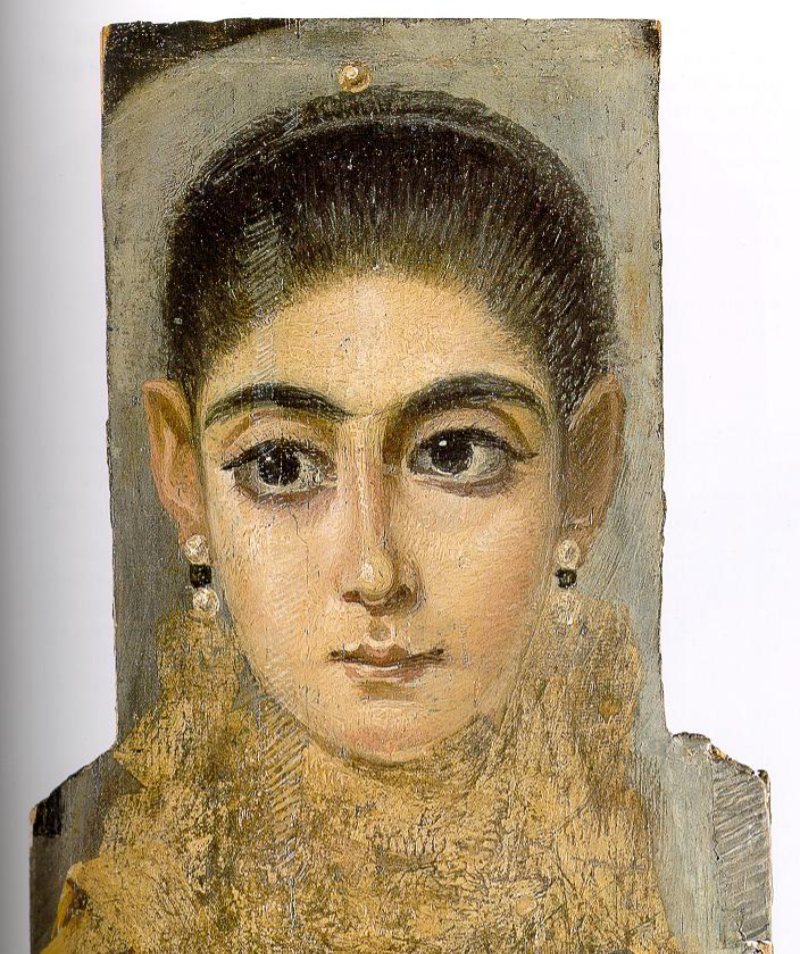
My position, and my Manifesto, can be summarized in two points:
One: that there is the purpose of art as commercial product if we define art as entertainment, a thing to bring us Pleasure – and this is a reasonable purpose: Art as Product, Product as Art.
As an example: this is how I approach my work on social media. I intend my work to represent a business (organization or project) in a manner that most effectively emphasizes the goals and the vision of that business (organization or project.) There is a specific purpose to this work.
Two: I bring my skills and creativity as an Artist (a painter) to my oil painting to produce a compelling work that moves into a place where it reaches an archetypal level – a level a little deeper a just a reasonable portrait of a person (for example) – a work that is more than just a snapshot or a selfie, a work – a painting – that has captured something essential of that individual and that human experience.
The modern idea of the “artist” – the Outsider, the Rebel, drinking and misbehaving and then turning out magnificent works that people like Art Critics, museums and well-heeled Art Collectors adore while we (the “public”) are expected to appreciate as “magnificent and valuable art works – is a deeply embedded paradigm as well as well as an illusion.
There is a truth to the cliche: I don’t know much about Art, but I know what I like. There is nothing wrong about that statement; it is honest, after all.
Some of the Great Works of Modern Art can be very shallow and even impenetrable, AND still worth a great deal of money!
Art, through human history, has always been about human experience, created by humans for humans. The Market for Art – well, that is a world unto itself. The artist’s patron over history could have been the village they lived in and their own community. It could also have been the Church, the Aristocracy, the Rich Merchants, the Capitalist Investors, or the Totalitarian State.
With modern technology and artificial intelligence now providing nearly anyone and anyone with the ability to produce all myriad forms of art quickly and cheaply, requiring only the right Prompt to produce thousands of images (of a Bored Ape, for example) in minutes, or a video, or a song, or a perhaps a full-length film… this is not art. This is technological breakthrough that will maximize and streamline the production process; a Capitalist Paradise, not a Worker’s Paradise.
I advocate for (what I call) the The Revolution by Hand. Despite the wonders (and potential terrors) of our technological achievements, there will always be a need for human expression of human experience. Tools are only tools, and technology no matter how sophisticated is still only a tool for the human user. To admire the tool as an end in itself is a false idea. A tool has no purpose unless it is put to use for a specific purpose.
To conclude: Marcel Duchamp submitted his “R.Mutt” urinal as a work of Art. That was a Dadaist joke, and yet now, here we are, decades later, where an artist (Damien Hirst) can exhibit dissected animal parts and we accept that as “groundbreaking” art – and quite expensive and valuable.
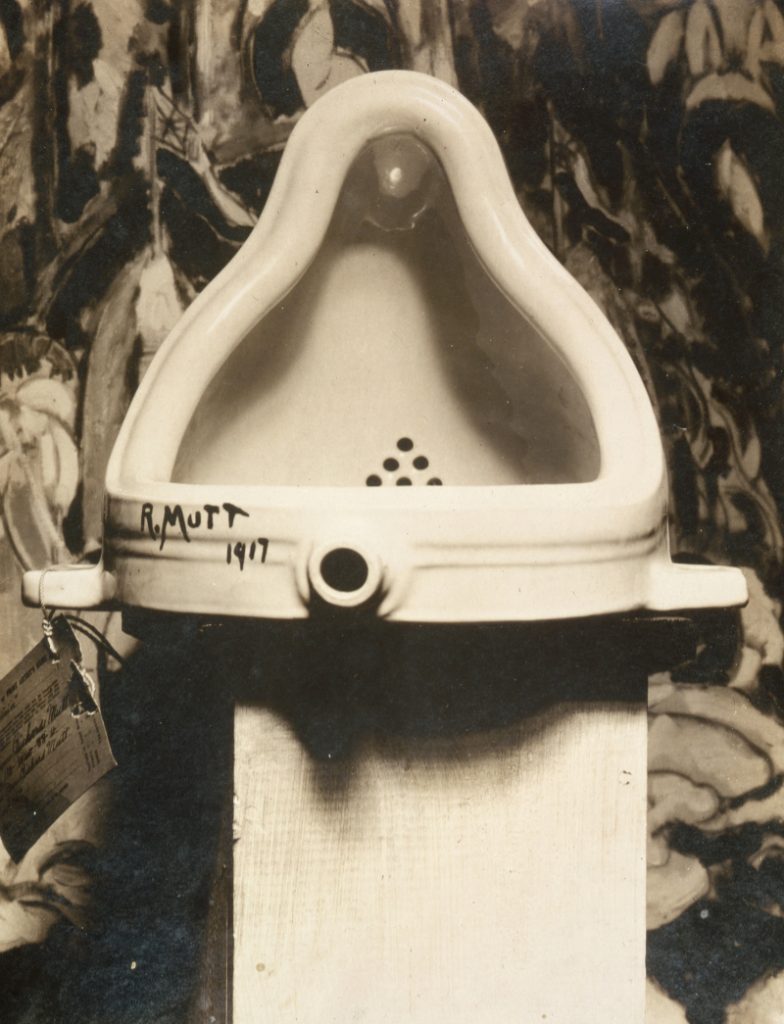
As an artist myself, I can take or leave the work of other artists. I have a simple approach to art in general: I ask myself: “does this work speak to me, does it inspire me?” It’s a good question when entering into art, any art.
Here is an image, a rabbit, painted by Albrecht Dorer in 1520. I admire this piece. I cannot say if Durer was a “nice guy” and I do not really care. It is an astounding work, done in (mostly) watercolor. It is a high-watermark piece for me: I hope that someday I can produce a similarly masterful work. I admire Durer for his skill, and the powerful presence he achieved.
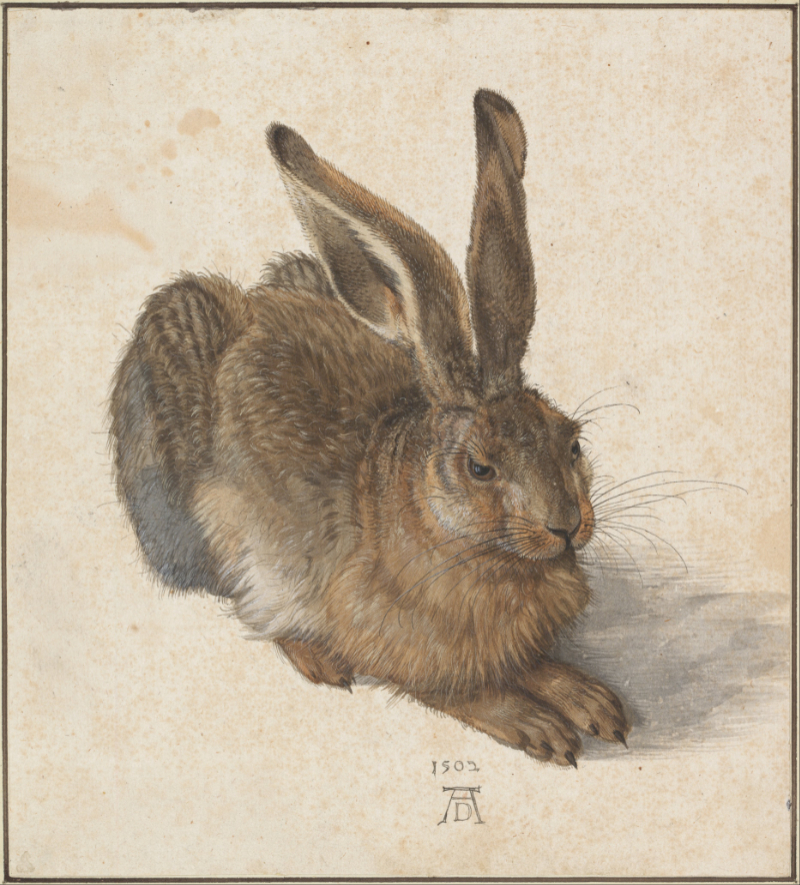
One more image: a portrait of my wife in the doorway of our first home together. I painted this because I was in love, and I hope that it shows. What can an A.I. know of love? It can calculate, but there is no soul: only algorithm.
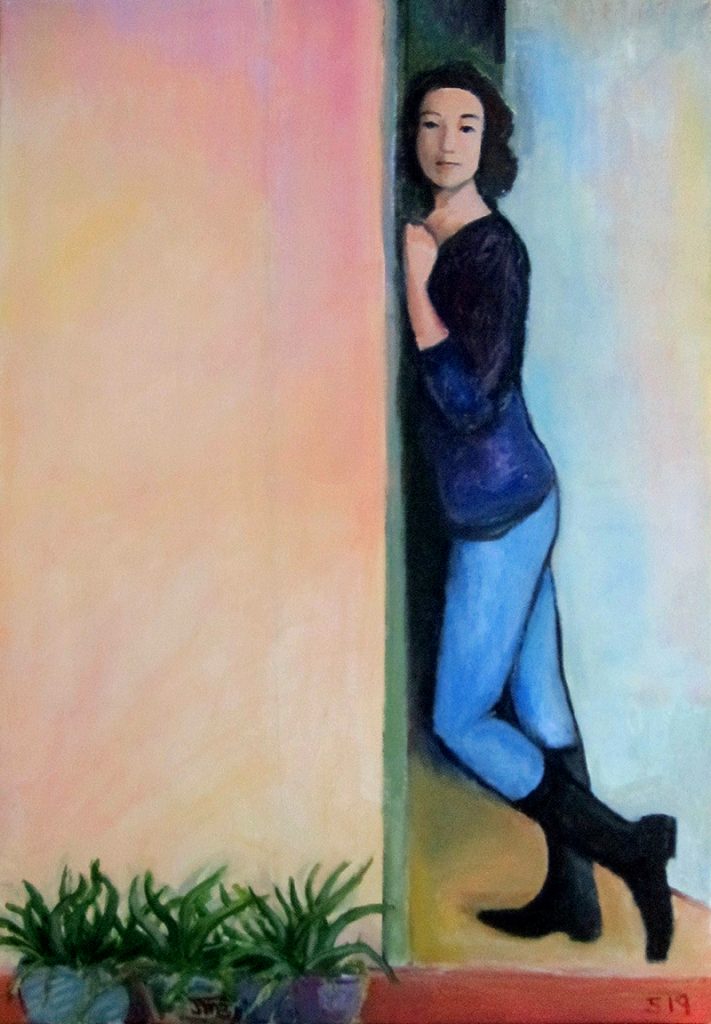
As an artist myself, I can take or leave the work of other artists. I have a simple approach to art in general: I ask myself: “does this work speak to me, does it inspire me?” It’s a good question when entering into art, any art. Is there evidence of “soul” – of a human experience that I may enter into, participate in?
Conclusion: perhaps anything can be “Art” but there is only one “Me.” I paint for myself, for others, and for Eternity. Perhaps one of my works will survive me and be appreciated in the years to come. I can only do what I feel is authentic, and authentic art is the only true art – human-to-human.
Stephen Michael
esem.studio
August 11, 2024
